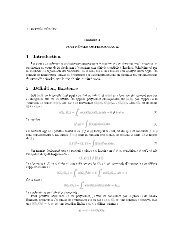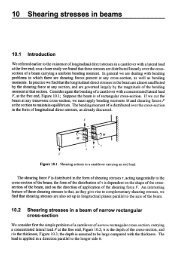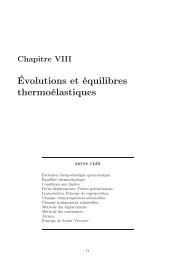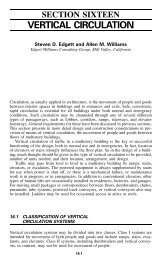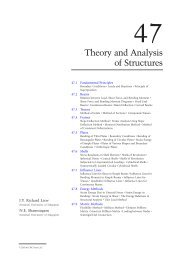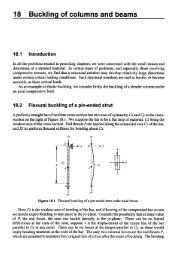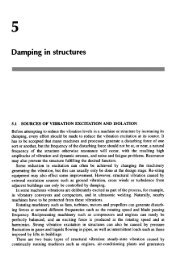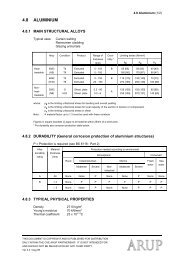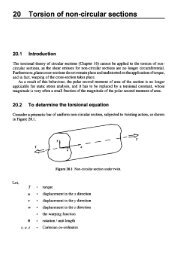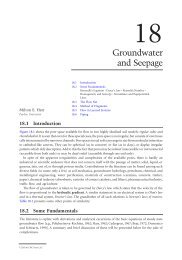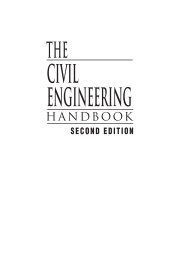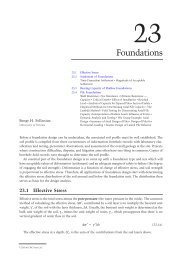Chapter 32 - Deep Foundations - Index of - Free
Chapter 32 - Deep Foundations - Index of - Free
Chapter 32 - Deep Foundations - Index of - Free
- No tags were found...
You also want an ePaper? Increase the reach of your titles
YUMPU automatically turns print PDFs into web optimized ePapers that Google loves.
andS shis the shortening <strong>of</strong> the pile itself, and can be expressed asSshflsi izi + pAb bzi= ∑ ( ∆ ) ( ∆ )E ( A)ici(<strong>32</strong>.22)wherep b= averaged loading pressure at pile tipA b= cross section area <strong>of</strong> a pile at pile tip; Ap b bis the total load at the tipD b= diameter <strong>of</strong> pile at the pile tipi = subscript for ith segment <strong>of</strong> the pilel = perimeter <strong>of</strong> a segment <strong>of</strong> the pile∆z = axial length <strong>of</strong> a segment <strong>of</strong> the pile; L= ∑ ∆zis the total length <strong>of</strong> the pile.f s= unit friction along side <strong>of</strong> shaft; fl is the side frictional force for segment <strong>of</strong> the pilesi i∆ziiE s= Young’s modulus <strong>of</strong> uniform and isotropic soilE c= Young’s modulus <strong>of</strong> the pileI bb= base settlement influence factor, from load at the pile tip (Figure <strong>32</strong>.4)I bs= base settlement influence factor, from load along the pile shaft (Figure <strong>32</strong>.4)Because <strong>of</strong> the assumptions <strong>of</strong> linear elasticity, uniformity, and isotropy for soil, this method isusually used for preliminary estimate purposes.Method by Vesic [79]The settlement S at the top <strong>of</strong> a pile can be broken down into three components, i.e.,iiS= Sb + Ss + Ssh(<strong>32</strong>.23)Settlement due to shortening <strong>of</strong> a pile isS Q Q Lsh= (p+ αs s)AEc(<strong>32</strong>.24)whereQ pQ sα sLAE c= point load transmitted to the pile tip in the working stress range= shaft friction load transmitted by the pile in the working stress range (in force units)= 0.5 for parabolic or uniform distribution <strong>of</strong> shaft friction, 0.67 for triangular distribution <strong>of</strong>shaft friction starting from zero friction at pile head to a maximum value at pile tip, 0.33 fortriangular distribution <strong>of</strong> shaft friction starting from a maximum at pile head to zero at thepile tip= pile length= pile cross-sectional area= modulus <strong>of</strong> elasticity <strong>of</strong> the pileSettlement <strong>of</strong> the pile tip caused by load transmitted at the pile tip isCQpSb=Dqop(<strong>32</strong>.25)© 2000 by CRC Press LLC



